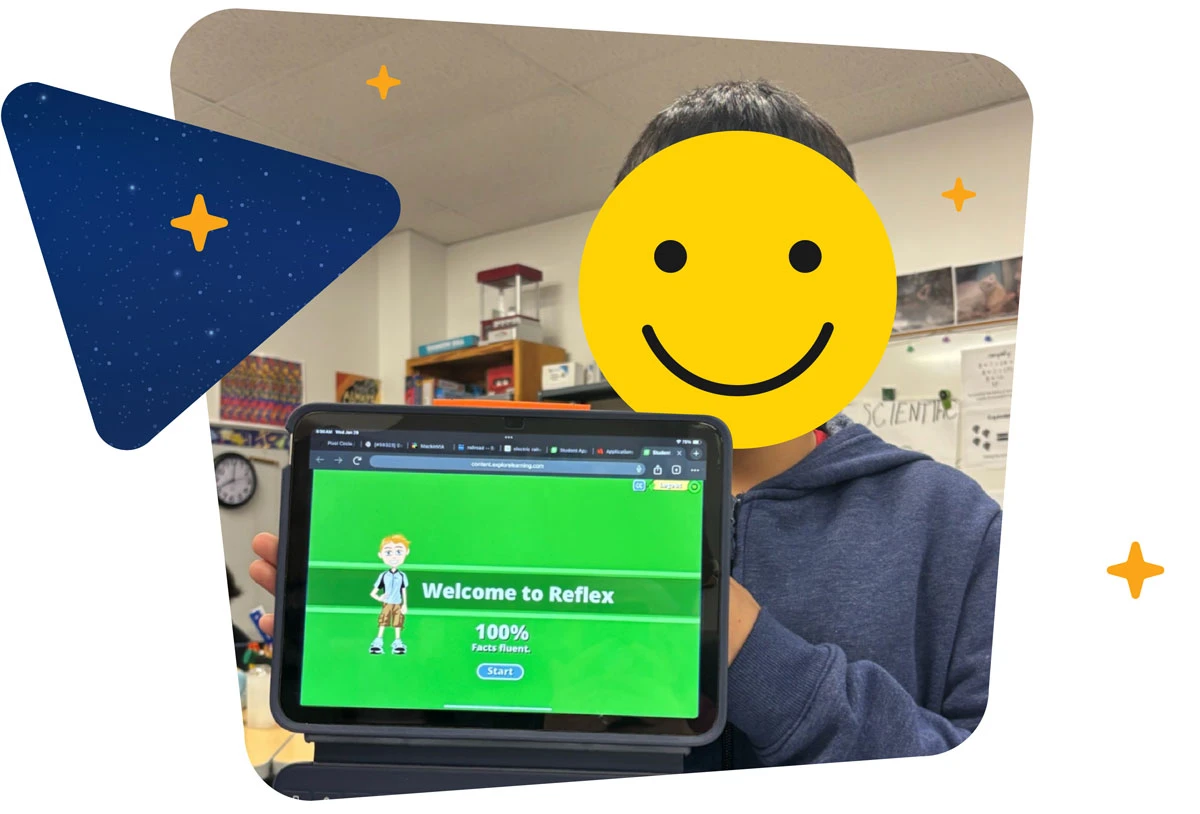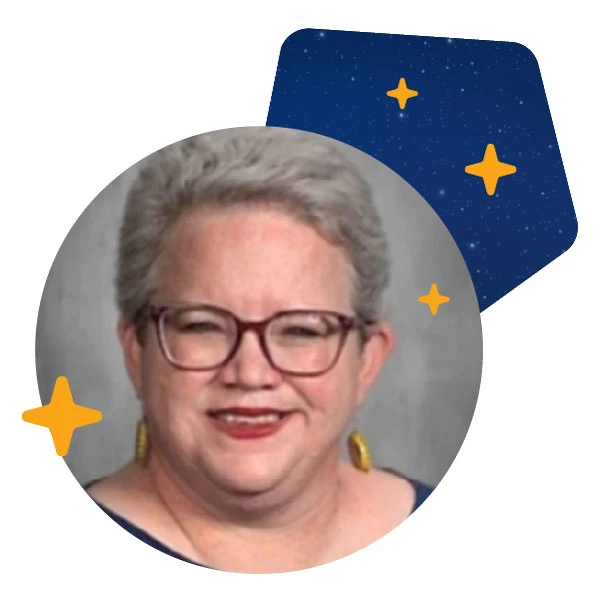- Home
- Success Stories
- Success Story Article
Building Curiosity and Connection: How a Texas Teacher Uses "Yes, And" to Support Dual Language Learners

After more than 30 years in the classroom, Christine Scovill, a fifth-grade math and science dual language teacher in Coppell, Texas, has mastered the art of empowering students to learn in both English and Spanish while honoring the knowledge they bring from home. “The whole philosophy of what we do is ‘yes, and,’” said Scovill.
By validating students’ experiences and encouraging a “yes, and” mindset, Scovill helps students and families see that learning can build on the strengths of each child’s native language and English. “For example, in English or Spanish, yes, that is a way of solving math, and this is a way of solving math—yes, and. We validate both experiences.”
Empowering learners in every language
Scovill, beginning her 33rd year of teaching, currently works at Denton Creek Elementary in Coppell Independent School District. She has taught everything from kindergarten to fifth grade, spending the last nine years in the dual language setting.
“In my current situation, I have half native Spanish speakers in my classroom and half native English speakers in my classroom. They begin the program either in kindergarten or first grade. They learn their own language and maintain that, and then add a second one. They continue that process all the way through middle school and high school,” said Scovill.
Supporting dual language STEM instruction with ExploreLearning
The math and science teacher discovered ExploreLearning products over fifteen years ago when she taught in Irving Independent School District. She continues to use Reflex and Frax, game-based elementary math solutions, along with Gizmos virtual STEM simulations and labs.
“Those pieces have been a standard part of what I use very heavily, especially the last nine years, but even prior to that. I’ve sought to write grants to bring the materials into the classroom because I see the hands-on benefit. I see the individualization of what happens,” said the teacher.
“I found the programs to be useful to be able to support populations with multiple languages, and to be something that enriches what I do in the classroom. There are not a lot of computer programs over time. They come, they go. There are trends, whatever is hot in the moment. This has been one of those things that—all of them—is very stable instruction, and it's driven by content. It's not driven by whatever is in at the moment. It's good, solid methodology.”
Listen to Christine’s Story!
“Anything I can do to make what I do in the classroom transparent, accessible, clear, and validate somebody's home experience as well as what we're required to teach—that promotes engagement and conversation with their family. That’s what I like about your products and your programs, and that's why I use them. –Christine Scovill
Motivating students with choice while building math fact fluency
Scovill started using Reflex for math fact fluency practice after a former math coordinator introduced her to the adaptive and game-based platform. “I've used that program consistently with every grade level I've taught. I've set the expectations to match the individual grade levels I've taught, whether it's addition, subtraction, multiplication, division, or a combination of all of those things. Reflex has been a part of my daily practice for at least the last 15 years.”
Reflex helps Scovill’s students build fluency in multiplication and division, which becomes critical for solving more complex problems in upper grades. The gamified element of choice also motivates her learners in new ways beyond traditional flashcards or worksheets.
“As they increase their fluency, they can pick between different games. Being able to pick and choose usually will keep them engaged,” said Scovill. “That element of choice—when you have to do something that is not giving you a lot of choice, for example, you have to memorize 6×9—if I can gamify that, then that gets me intrinsic motivation enough to keep going. And that’s what I see as the power of that particular program and why I like it.”
Scovill sets SMART goals with her students and celebrates math fact milestones, which is especially meaningful for learners who have struggled academically or linguistically. She also uses the data reports to communicate progress with families. “With Reflex, it's very, very, very concrete for families to understand exactly what it's like. You can pull up that pyramid and show them, you know, 25 correct answers or presentations that help transfer short-term to long-term memory.”

One of Scovill’s students showing off 100% fluency on Reflex.
Turning fractions into fun with a Frax classroom grant
For fractions, Scovill introduced Frax into her classroom routine four years ago after trying the space-themed learning platform with a math grant.
“I brought it into my classroom in the second and third grade. I work with half native Spanish speakers and half native English speakers. With that population, there are sometimes populations of learners who haven’t had equivalent schooling in their home countries. Using that Frax program has allowed me to build some competencies and their knowledge in working with fractions that wouldn’t have been there otherwise.”
“I wrote the grant and made sure that it was assigned as licenses to learners in particular, who were second-language speakers learning English, that needed support with fractions because that can be a particularly difficult concept all the way through. After having that, I wrote a grant to get the PTO to license it for us. And now, beginning this year, I met with my mathematics coordinator for the district three weeks ago, and they're bringing it in for the district.”
Bridging school and home life with virtual simulations
Scovill began using Gizmos virtual simulations after applying for a grant. “I went to the training, and I really liked how they used real-life experiments. They let you run simulations of the data over and over and over again. I’ve always implemented that as part of my lesson plans,” said Scovill. “I leaned on [Gizmos] particularly heavily during the beginning of COVID because it allowed the children to have experiences with something that I couldn't physically bring to them.”
In her dual language classroom, Scovill uses Gizmos to bring complex STEM topics to life in understandable ways. “It gives me that connection to something that is concrete. It bridges that gap with things that can be sort of abstract,” said Scovill. “What I usually get is some very innate interest and engagement right there, because they have the power to manipulate things. So I use it in that way to personalize extensions.”
For multilingual families, Gizmos offer visual, hands-on experiences that can transcend language and school walls. “When you're working with a group that is a second language group, [Gizmos] also give you enough visuals and interaction that I can use that with the families, so that those parents can have that discussion in the native language that they have, but they're still addressing the content,” said the teacher.
“If I can give that to the families, then I've given them hopefully a basis for going on to have those discussions and to really try to validate that what they speak to them about at home or what they've learned at home is a ‘yes, and’ mentality.”
Engaging families with real-world learning connections
When Scovill started teaching in Coppell, she made Gizmos a part of family night activities. “When we have parent nights, I will show the parents how to use that application as well, because it promotes conversation with their learner. They can change variables. They can talk about what they see in the experiment.”
“When we bring the parents in, the first thing we do is get them through the single sign-on platform so they can get logged in. I usually begin by showing them several of the simulations. That's when I get the wide eyes, and I get the Oooh, that’s neat. Then I say, ‘You know, your tax dollars are paying for this,’ so I want to make sure you have full access to how this works.”
Scovill's goal is to connect families with their students and the topics they’re learning during the day. “Sometimes it's just physically putting your hands on the simulation and talking about the content. But I hope what it means with those pieces—and I think what comes from parent night—is that I see those parents feel a sense of how they can benefit and how they can connect.”
Whether it’s a student connecting a lesson on friction to a scooter ride later that evening, or a child seeing the crossover between an interactive Gizmo and an experience on his grandfather’s farm, Scovill knows the power of meaningful connections when it comes to solidifying knowledge. “That's how I want you to make sure you're connecting what we do in class to what we're trying to connect to the real world.”
“I know I've been successful if the kids come back and say, ‘My dad and I did this.’ Or, ‘My mom and I did this.’ That’s the piece of it—of making sure that they feel connected to the content—is something that I see from those parent nights that then travels home.” –Christine Scovill
Through authentic, engaging instruction and the use of classroom tools, Scovill fosters real-world connections that inspire students and families long after they leave her classroom. “That's what Gizmos or Reflex or Frax gives us, is ‘yes, and.’ That is the way I kind of want them to approach looking at any number of things. The career field they will hold will not necessarily be the same career field that I even know is out there right now. I want them to have an open mindset, and I want them to have multiple avenues to look at things.”
Finding joy in creating confident learners
For the veteran educator, teaching is as much about affirming students’ identity as it is about building skills. “My favorite part about my work, and the thing that gives me the most satisfaction, is if somebody walks away from me and feels better about themselves for having interacted with me. That’s the joy I take from it,” said Scovill. “It sounds a little cliché, but it’s the chance to help somebody become who they want to be.”
“Those little pieces are what make the job joyous in the midst of a lot of challenging things that we’re going through—politically, socially, economically—all those different pieces. I get the daily joy of being able to see how what I gave you helps you become what you want to be. That’s what keeps me in the profession.”
Experience how ExploreLearning can help you inspire confidence and growth in every learner. Start your free trial today!

About Christine Scovill
Christine Scovill has been teaching for more than 30 years. She is currently a fifth-grade dual language teacher at Denton Creek Elementary in Coppell, Texas.
You might also like these stories...
